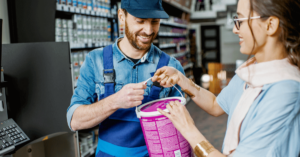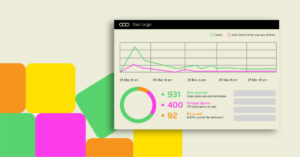Whether you’re at the end of a B2B customer loyalty program life cycle, or simply need to reassure stakeholders of the program’s value, proving customer loyalty growth is a key part of running a loyalty program. That means you need to know which key performance indicators (KPIs) to track and how each of them impacts your loyalty program’s success. We’ve broken down the most reliable KPIs to track B2B customer loyalty growth and how to derive insight from those KPIs.
To begin with, key performance indicators can be divided into two groups: leading indicators and lagging indicators.
How to Prove B2B Customer Loyalty Growth: Leading Indicators
Leading indicators are the metrics leading up to success. You should measure leading indicators frequently (weekly, sometimes even daily) so you can intervene quickly if you’re not hitting your goals.
Leading Indicator: Onboarding
Positive onboarding KPIs signal that your program is off to a great start. Pay close attention to program onboarding metrics such as registration and account activation and have a plan in place if onboarding KPIs aren’t ideal.
Make sure you start the program invitation process with clean data. If you’re using email to announce the program’s launch or invite select participants, all emails should be up to date. This helps you avoid unsubscribes and spam penalties, and ensures you have accurate data on your audience’s interest in the program.
Enrollment Percentage
Is your targeted audience signing up for the program? If not, that indicates you should research why they are not. Email open/click rates can help you determine where your messaging is losing your audience.
How to Increase Enrollment
Try changing your messaging or (if you’re running a points-based program) offering enrollment bonus points to get participants engaged right off the bat.
A low enrollment percentage can also be an early sign that you misjudged your audience, so consider tweaking the audience or targeting a different group.
Average Enrollment Time
Check the time it takes for a participant to enroll in your program after getting invited. A short enrollment time is a sign that your program has a clear value proposition and an easy enrollment process.
How to Improve Average Enrollment Time
If the average time to enroll is longer than a couple of days, look for ways to simplify the enrollment process. Single sign-on (SSO) functionality is the best way to ensure participants can easily find and remember your program website.
Average Time to Enroll Benchmarks
Note that there are two kinds of B2B customer loyalty program enrollment that will result in different benchmarks for how long it takes your audience to enroll. There’s the closed enrollment, where only people you invite can join the program. Then there’s open enrollment, where anyone can sign up for your program.
Here are some benchmark enrollment metrics you can expect from a B2B loyalty program that’s on its way to success:
Closed Enrollment
- After one year, an average of 60% of the enrolled participant audience was active in the program. (Source: Extu case study)
- After two years, an average of 75% of enrollees were active. That number stabilized until year five. (Source: Extu case study)
Open Enrollment
- After one year, 24% of the enrolled participant audience was active, on average.
- The number of active participants among enrolled participants increased to 34% after two years.
Leading Indicator: Connection
Despite how great your loyalty program is, at least 38% of your audience is likely to forget about it. That’s why reaching out through email or texts is essential to re-engaging channel partner loyalty. These KPIs will tell you if your participants are seeing the messages you send.
Email Open Rates
Open rates for rewards-related emails can be up to 2X higher than industry benchmarks. If your program isn’t getting those rates, it could be a sign that your emails aren’t relevant to your audience, or the cadence is either too often or too infrequent.
How to Improve Email Open Rates
Poor open rates can also indicate that your headlines aren’t attention-grabbing. Tweak subject lines to make your program’s appeal immediately clear and compelling. Personalized subject lines and messaging can have a big impact on your open rates.
According to a Corporate Visions webinar, all else being equal, subject lines and openings that personalize copy with company + individual have optimal open rates.
Don’t take this as a hard and fast rule, since everyone’s audience is different. But it gives you an idea of how to tweak your emails for better open rates.
Email Open Rate Benchmarks
- The average open rate in B2B industries for emails not related to loyalty programs varies depending on the industry, but it’s typically 15%–25% (Source: CampaignMonitor).
- For incentive and loyalty program emails, you should aim for average open rates around 48%. Loyalty programs should have higher-than-average open rates because of their high personal relevance (Source: Extu case study).
Email Click-Through Rates
Email click-through metrics help you determine how engaging your program messaging is. Maybe your participants are opening your emails, but not following up on any calls to action. Keep emails clear, concise, and engaging. The competition for your participants’ attention is noisy.
How to Improve Click-Through Rates
If you aren’t seeing the click-through rates you’d like from your program emails, try experimenting with your emails’ cadence, messaging, and the order in which they receive different assets and media. In the same Corporate Visions webinar mentioned in the last section, they found that:
- Optimal outbound contact is between eight and 14 attempts.
- Reaching out via three different types of media vs one increases quadrupled contact rates.
- The most effective opportunity-creating content send is a short video followed by a short infographic at the sixth and eleventh touches.
Again, these findings may not apply to your audience, but you might find that a particular combination of sequence of media or messaging resonates with your program participants.
Leading Indicator: Engagement
Getting your partners on board is good. Connecting with them is better. Making sure they’re engaged is essential. Keeping track of engagement KPIS can tell you if your B2B customer loyalty program is truly “sticky” or not.
Number of Log-Ins
The average number of logins tells you how frequently your audience uses your program. If this number is low, it could be a sign that people don’t remember how to reach your program, or they easily forget it exists.
How to Increase Logins
Single sign-on (SSO) capability—where your audience can reach multiple areas of your web presence through one log-in—greatly improves your program’s accessibility. This removes the need to remember a separate website or log-in credentials.
Awards or Points Distribution
One of the best tests for your engagement success is seeing how many awards or points have been distributed. A high distribution means your B2B customer loyalty program is successfully incentivizing employees the way your partners want.
Reward Points Distribution Benchmarks
- Reward distribution rate should average 45% by one year.
- Reward distribution rate should increase to 60% by year two.
- Reward distribution rate should increase by about 10% every year after that until year five. (Source: Extu whitepaper)
Reward Redemption
For those who have a point-based digital award system, you have an added opportunity for program insight: reward redemptions. If employees are failing to redeem points, that’s a sign that you may need a redemption marketing campaign. Adding an expiration date to your points can also instill a sense of urgency in your participants.
How to Increase Reward Distribution and Redemption
Carefully balance award distribution and award cost so that the ROI is positive when your audience earns a reward.
If you find that not many people are earning awards or reward points, make changes to the definition of a reward-earning action, or make it easier for participants to earn rewards. For instance, if you reward participants for submitting qualifying sales, offer them a file upload tool so they can easily and quickly upload invoices, receipts, and other documentation verifying their reward claim.
Reward Redemption Benchmarks
- The percentage of active participants redeeming for rewards they’ve earned should reach 39% after the first year. (Source: Extu whitepaper)
- The percentage of active participants redeeming for rewards should peak at 67% in the third year, plateauing at this number until year five. (Source: Extu whitepaper)
How to Prove B2B Customer Loyalty Growth: Lagging Indicators
Lagging indicators are the metrics that prove success. These tell you if money is coming in and if your participants are staying loyal to your program.
Lagging Indicator: Sales Growth
Ideally, you’d like for your loyalty programs to boost sales. The good news is that improved customer loyalty grows sales in a variety of ways—from increasing the average order size and frequency of existing customers to increasing referrals that earn you new business. Track these sales KPIs to see how your loyalty program is contributing to revenue.
Overall Sales Increase
Compare the organization’s overall sales performance against the sales specifically resulting from the loyalty program. A significant decrease or increase of sales may be due to more factors than just your incentive program.
Overall Sales Increase Benchmarks
A successful loyalty program should increase sales by about 30-40%. (Source: Extu case studies)
Sales Increase of Specific Product or Audience
Your program should discern how many of your sales are from participants, and how many are from non-participants. Ideally, your participants should be generating a significant number of sales.
Specific Product Sales Benchmarks
A successful loyalty program should increase sales of a specific product by about 40%. (Source: Extu case study)
Average Order Size and Frequency
An increase in size and frequency of your average order is a good sign that the program is effectively influencing your audience’s behaviors.
Average Order Size Benchmarks
A successful loyalty program can boost average order size by about 8X. (Source: Extu case study)
How to Increase Sales Metrics
There’s no single magic bullet to improve the sales metrics your loyalty program achieves. Initial success will depend greatly on a harmony between your target audience, your program goals, actions that earn rewards, and the rewards you offer. In order to improve your program’s results, you should try all the previously mentioned tactics for each KPI, and keep these basics in mind when it comes to rewards:
- Reward points programs allow participants to save up rewards over time, then spend their points on whatever they want most in a big rewards catalog, making reward points an excellent tool to motivate large, diverse customer and employee audiences in the long-term.
- Debit and gift card rewards are versatile, and everyone understands them, so the time between reward-earning and reward redemption tends to be short. These qualities make them perfect for sales performance incentive funds (SPIFFS) for short-term sales promotions.
- Group travel incentives historically have the highest return on investment (ROI) of any reward and lead to cherished, shared memories that build life-long relationships and loyalty. This makes group travel incentives perfect for top performers as well as MVP clients or customers.
Lagging Indicator: Retention
Retention data requires a long-term perspective, but it can be the clearest look into the staying power of your program.
Participant Retention Rate
Of the B2B customers you’ve retained, how many are participants in your channel partner loyalty program? It’s great if you’re keeping customers, but it’s not such a great sign if your loyalty program has nothing to do with that retention.
Satisfaction Surveys
Sometimes the clearest indication of your success comes right from the mouth of your participants. A survey can show you how your participants feel and reveal areas or improvement you may not have considered.
Satisfaction Benchmarks
Successful loyalty programs should achieve 95-97% satisfaction and participation rates. (Source: Extu case study)
Testimonials and Referrals
Having a good story under your belt can make all the difference. Tracking business resulting from testimonials and referrals shows auxiliary revenue you can attribute to your loyalty program.
How to Increase Retention Metrics
Increasing your retention metrics will be directly tied to your success in engaging your audience. Continuously boosting engagement by improving marketing messaging and ease of program access. Reward variety and personalized rewards will also improve engagement and retention.
Conclusion:
Access to KPI data is essential to business success. According to Forrester, firms that are driven by advanced data insights are 8.5% times more likely than other firms to report that their annual revenue grew by 20% or more.
If you want a look into these insights and the tactics you can take to get a strong ROI on your B2B customer loyalty program, check out our free eBook.
If you want a service that takes care of channel data insights for you, reach out to us.



